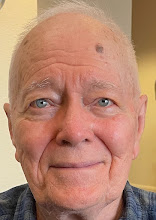01 00:00 nail in foot
A man screams in terrible pain on seeing that a nail penetrated his work boot. The nail went between his toes with no injury.
02 01:48 prediction machine
His brain predicted that a nail through his boot would hurt bad therefore it did.
03 02:50 hollow mask
A clear face mask appears to face you when it does and when it does not even though you can see the difference. Your current observation cannot correct your strong expectation.
04 06:40 sine-wave speech
An altered speech is played; then normal speech; and then the altered speech again. The first sample is not understandable; the second time it is played it is understandable. [Andy Clark has an accent. I had little problem on the second or third play of this presentation.]
05 09:20 guessing machine
The brain is always trying to guess what will happen next.
06 09:44 modified prediction
Raw sensory information is never experienced: it is always modified.
07 11:20 predictive processing (PP)
How the brain balances predictions and sensory information.
08 12:18 books
Predictive processing or active inference and emotions.
09 14:45 predicting the present
This leaves the need to deal with residual errors.
10 15:00 prediction errors
Only these need further processing.
11 17:00 1959 TV cartoons
Early TV signals only transmitted what changed between frames.
12 18:35 inside out
There is more wiring carrying information out than in.
13 18:40 energy budget
Most of the energy is spent maintaining the generative models that issue predictions.
14 19:30 pression weighting
The brain estimates how much information to take from the model and from sensory experience.
15 25:50 high sensory
This is high in relation to model information, not high as a count.
16 26:27 autisim
High sensory information results in autistic behavior; seeks quiet places.
17 28:38 high predictions
This is high in relation to sensory information.
18 28:48 hallucinations
High model information results in hallucinations.
19 30:15 alter sensory experience
Strong predictive models can alter sensory experience.
20 30:30 self-confirming cycles
This can lead to self-confirming cycles.
21 31:07 experimental verification
Expectation creation,” real stimuli”, expectation-induced effects reported.
22 33:32 chronic pain
Is poorly related to a cause.
23 36:39 idiosyncratic predictive
This gets related to more “causes” with more time.
24 38:01 install different predictions
The good news is to install different predictions.
25 38:17 placebos
Surgery, athletes, and “honest” placebos.
26 40:36 pain reprocessing theory (PRT)
With the ChronicPain Cycle the prediction becomes the problem.
27 44:48 psychosomatic (FND)
Functional neurological disorder with no cause 16%.
28 45:18 sensorimotor aspects
Unexplained cases of fatigue, weakness, and tremor.
29 45:45 loss of vision
Full recovery (as happens in high quality memory care).
30 48:43 mind/body one
The mind and body dualism model creates a false divide between psychiatry and neurology.
31 49:45 hack predictive brains
Using virtual reality (VR) to alter precision-weightings and seed alternative predictions.
32 50:34 verbal reframing
Providing alternative views in a non-threating environment.
33 51:13 meditation
A powerful way of gaining control over the precision-weight aspect of our prediction machinery.
34 52:33 large differences between individuals
This suggest genetic differences.
35 55:58 predictive processing (PP) evolving into a scientific theory
Associating the big picture with specific implementation commitments makes things testable.
36 56:37 the relationship between conscious and unconscious predictions
No one knows.
37 57:04 the interplay between predictive brains and human-built worlds
Material culture and its influence on the predictive brain.
38 57:37 predictive brains will share the world with AI forms of predictive intelligence
This new environment will select for a reshaped species in the future.
39 58:04 why and how conscious experience is possible
Books.
40 58:50 a small set of factors combine to yield a striking range of differences in experiences
(Predictions, precisions, and prediction errors} as in chemistry (the periodic table of the elements) and evolution (DNA).

No comments:
Post a Comment